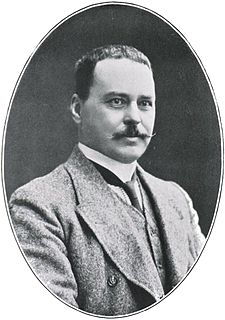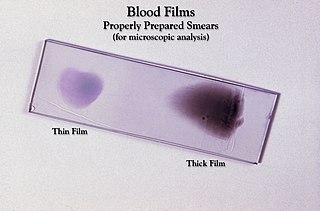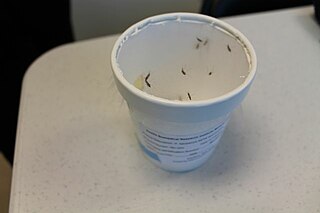
Dichlorodiphenyltrichloroethane, commonly known as DDT, is a colorless, tasteless, and almost odorless crystalline chemical compound, an organochlorine, originally developed as an insecticide, and ultimately becoming infamous for its environmental impacts. It was first synthesized in 1874 by the Austrian chemist Othmar Zeidler. DDT's insecticidal action was discovered by the Swiss chemist Paul Hermann Müller in 1939. DDT was used in the second half of World War II to control malaria and typhus among civilians and troops. Müller was awarded the Nobel Prize in Physiology or Medicine "for his discovery of the high efficiency of DDT as a contact poison against several arthropods" in 1948.

Quinine is a medication used to treat malaria and babesiosis. This includes the treatment of malaria due to Plasmodium falciparum that is resistant to chloroquine when artesunate is not available. While used for restless legs syndrome, it is not recommended for this purpose due to the risk of side effects. It can be taken by mouth or used intravenously. Malaria resistance to quinine occurs in certain areas of the world. Quinine is also the ingredient in tonic water that gives it its bitter taste.
Romanowsky staining is a prototypical staining technique that was the forerunner of several distinct but similar methods, including Giemsa, Jenner, Wright, Field, May Grunwald stain and Leishman stains, which are used to differentiate cells in pathologic specimens. It was named after the Russian physician Dmitri Leonidovich Romanowsky (1861–1921), who invented it in 1891.

Sir Ronald Ross, was a British medical doctor who received the Nobel Prize for Physiology or Medicine in 1902 for his work on the transmission of malaria, becoming the first British Nobel laureate, and the first born outside Europe. His discovery of the malarial parasite in the gastrointestinal tract of a mosquito in 1897 proved that malaria was transmitted by mosquitoes, and laid the foundation for the method of combating the disease. He was a polymath, writing a number of poems, published several novels, and composed songs. He was also an amateur artist and natural mathematician. He worked in the Indian Medical Service for 25 years. It was during his service that he made the groundbreaking medical discovery. After resigning from his service in India, he joined the faculty of Liverpool School of Tropical Medicine, and continued as Professor and Chairman of Tropical Medicine of the institute for 10 years. In 1926 he became Director-in-Chief of the Ross Institute and Hospital for Tropical Diseases, which was established in honour of his works. He remained there until his death.

Plasmodium is a genus of unicellular eukaryotes that are obligate parasites of vertebrates and insects. The life cycles of Plasmodium species involve development in a blood-feeding insect host which then injects parasites into a vertebrate host during a blood meal. Parasites grow within a vertebrate body tissue before entering the bloodstream to infect red blood cells. The ensuing destruction of host red blood cells can result in disease, called malaria. During this infection, some parasites are picked up by a blood-feeding insect, continuing the life cycle.

A blood film—or peripheral blood smear—is a thin layer of blood smeared on a glass microscope slide and then stained in such a way as to allow the various blood cells to be examined microscopically. Blood films are examined in the investigation of hematological (blood) disorders and are routinely employed to look for blood parasites, such as those of malaria and filariasis.

Plasmodium falciparum is a unicellular protozoan parasite of humans, and the deadliest species of Plasmodium that cause malaria in humans. It is transmitted through the bite of a female Anopheles mosquito. It is responsible for roughly 50% of all malaria cases. It causes the disease's most dangerous form called falciparum malaria. It is therefore regarded as the deadliest parasite in humans, causing 435,000 deaths in 2017. It is also associated with the development of blood cancer and is classified as Group 2A carcinogen.
Blackwater fever is a complication of malaria infection in which red blood cells burst in the bloodstream (hemolysis), releasing hemoglobin directly into the blood vessels and into the urine, frequently leading to kidney failure. The disease was first linked to malaria by the Sierra Leonean physician Dr John Farrell Easmon in his 1884 pamphlet entitled The Nature and Treatment of Blackwater Fever. Easmon coined the name "blackwater fever" and was the first to successfully treat such cases following the publication of his pamphlet.

Giemsa stain, named after German chemist and bacteriologist Gustav Giemsa, is used in cytogenetics and for the histopathological diagnosis of malaria and other parasites.

Plasmodium vivax is a protozoal parasite and a human pathogen. This parasite is the most frequent and widely distributed cause of recurring malaria, P. vivax is one of the five species of malaria parasites that commonly infect humans. Although it is less virulent than Plasmodium falciparum, the deadliest of the five human malaria parasites, P. vivax malaria infections can lead to severe disease and death, often due to splenomegaly. P. vivax is carried by the female Anopheles mosquito; the males do not bite.
Plasmodium knowlesi is a primate malaria parasite commonly found in Southeast Asia. It causes malaria in long-tailed macaques, but it may also infect humans, either naturally or artificially.

Malaria vaccine is a vaccine that is used to prevent malaria. The only approved vaccine as of 2015 is RTS,S, known by the trade name Mosquirix. It requires four injections, and has a relatively low efficacy. Due to this low efficacy, the World Health Organization (WHO) does not recommend the routine use of the RTS,S vaccine in babies between 6 and 12 weeks of age.

Avian malaria is a parasitic disease of birds, caused by parasite species belonging to the genera Plasmodium and Hemoproteus. The disease is transmitted by a dipteran vector including mosquitoes in the case of Plasmodium parasites and biting midges for Hemoproteus. The range of symptoms and effects of the parasite on its bird hosts is very wide, from asymptomatic cases to drastic population declines due to the disease, as is the case of the Hawaiian honeycreepers. The diversity of parasites is large, as it is estimated that there are approximately as many parasites as there are species of hosts. Co-speciation and host switching events have contributed to the broad range of hosts that these parasites can infect, causing avian malaria to be a widespread global disease, found everywhere except Antarctica.

Parviz Shahbazi is an Iranian filmmaker.

Private Snafu vs. Malaria Mike is an animated short film, directed by Chuck Jones and first released in March, 1944. It features Private Snafu facing a malaria-transmitting mosquito.
The mainstay of malaria diagnosis has been the microscopic examination of blood, utilizing blood films. Although blood is the sample most frequently used to make a diagnosis, both saliva and urine have been investigated as alternative, less invasive specimens. More recently, modern techniques utilizing antigen tests or polymerase chain reaction have been discovered, though these are not widely implemented in malaria endemic regions. Areas that cannot afford laboratory diagnostic tests often use only a history of subjective fever as the indication to treat for malaria.

Mary and Martha is a 2013 British-American television film starring Hilary Swank and Brenda Blethyn, and directed by Phillip Noyce. Based on a screenplay by Richard Curtis, it was produced by Working Title Television, in association with the BBC and NBCUniversal. The film had its UK premiere on 1 March 2013 on the BBC and premiered in the US on HBO on 20 April 2013. The film is based on a true story. The film centers around two mothers, one British, one American, who share only one thing in common: the loss of their sons to malaria. After the deaths of their sons, the mothers decide to travel to Africa to help with malaria prevention. The film was nominated for the Humanitas Prize.
Kilimani Sesame is the Tanzanian version of Sesame Street. The show airs on Tanzania Broadcasting Corporation (TBC) and Television Zanzibar (TVZ). 13 episodes have been produced.













